
Today, you’re going to learn the:
- Similarities;
- Differences, and;
- Interactions,
Between THC and CBD.
We reviewed 27 studies that looked at the effects of both compounds.
The conclusion?
CBD and THC have some similarities, many differences, and a few important interactions.
The best part?
You’ll get an effective method to improve the effectiveness of both compounds by a specific science-backed ratio.
Table of contents:
What Are the Similarities Between CBD and THC?
What Are the Differences Between CBD and THC?
What Are the Interactions Between CBD and THC?
The Benefits of Taking CBD and THC Together
Science-Backed Ratios to Improve Effectiveness of CBD and THC
Is CBD or THC Better for Pain?
Isolate vs. Full-Spectrum CBD + THC
1. What is CBD?
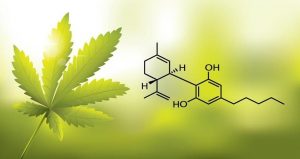 CBD, or cannabidiol, is a naturally occurring compound found in cannabis.
CBD, or cannabidiol, is a naturally occurring compound found in cannabis.
Both the marijuana and hemp varieties of the cannabis plant contain CBD.
CBD is associated with a wide range of positive health benefits.
Some of the most well-documented benefits of CBD are:
- Its anti-inflammatory effects, and;
- Its anxiety-reducing effects.
CBD’s interaction with various receptor systems is what’s responsible for CBD’s positive health benefits.
Studies show that CBD interacts with the following receptor types:
- The CB1 and CB2 (cannabinoid 1 and 2) receptors;
- the GPR55 receptor (this is a different type of cannabinoid receptor);
- Glycine receptors;
- Adenosine receptors, and;
- Vanilloid receptors.
Ever since hemp-derived CBD got federally legalized in 2018, the CBD market has grown exponentially.
Today you can get all sorts of CBD products:
- Oils and tinctures;
- Gummies;
- Creams;
- Powders, and;
- Vape products.
All of these products have their own benefits and downsides.
But the main ingredient that connects them all is CBD.
Related: What Is CBD Oil: The Beginner’s Guide
2. What is THC?
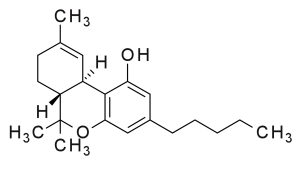
THC is an abbreviation for delta(9)-tetrahydrocannabinol.
It’s the principal psychoactive compound in cannabis. THC is the most extensively researched compound inside cannabis.
A simple PubMed search with the term “tetrahydrocannabinol” retrieves more than 10.000 studies.
Like CBD, THC is associated with various health benefits as well.
Some of the most well-documented health benefits of THC are its:
- Painkilling and anti-inflammatory effects;
- Anti-oxidant and neuroprotective effects, and;
- Nausea-reducing effects.
THC also produces its effects by interacting with various receptor systems, including:
- CB1 and CB2 (cannabinoid) receptors;
- PPAR-γ (glitazone) receptors;
- TRPA1 (vanilloid) receptors;
- 5HT3A (serotonin) receptors;
- glycine receptors;
- TRPM8 (cold and menthol) receptors, and;
- TRPV2 (vanilloid) receptors.
THC’s interaction with the CB1 receptor is responsible for its psychoactive effects.
Unlike CBD, THC as a stand-alone compound is federally illegal.
However:
Cannabis plants that contain less than 0.3% THC and products derived from these plants are federally legal.
3. What Are the Similarities Between CBD and THC?
The biggest similarity between CBD and THC is that they’re both ‘cannabinoids’.
Cannabinoids are a specific type of compound only found in cannabis plants (both inside marijuana and hemp varieties).
All cannabinoids have a similar chemical structure. They also interact with some of the same receptor systems.
For example:
Both THC and CBD interact with the following receptor systems:
- CB1 and CB2 (cannabinoid) receptors;
- Serotonin receptors;
- Vanilloid receptors;
- Glycine receptors.
Although keep in mind that even though both CBD and THC interact with the CB1 and CB2 receptors, how each interacts differs significantly.
For example, THC is an agonist (activator) of the CB1 and CB2 receptors. CBD is an antagonist (blocker) of the CB1 and CB2 receptors.
Plus, THC has a much stronger affinity to interact with the CB1 and CB2 receptors than CBD (1).
THC and CBD are also associated with similar health benefits.
For example, both THC and CBD are associated with:
But again, this doesn’t mean that THC and CBD produce these health benefits through the same mechanism of action.
Because there are also some major differences between the compounds.
4. What Are the Biggest Differences Between CBD and THC?
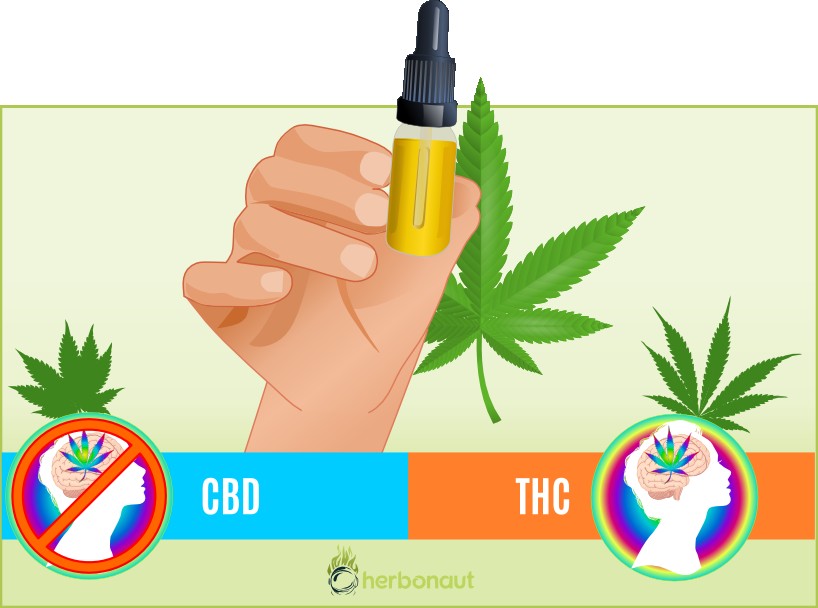
The biggest difference between THC and CBD is that:
THC produces psychoactive effects and CBD doesn’t.
THC is the compound in cannabis that gets you high. And while CBD can help you relax, it won’t produce a high.
It’s thought that THC’s activation of the CB1 receptor is what causes the psychoactive effects (4).
THC’s psychoactive effects are exactly the reason why THC as a stand-alone compound is federally illegal.
The difference in side effects
While recreational users are looking for a ‘high’…
For medical users of cannabis products, THC’s psychoactive effects are often unwanted side effects.
Especially high doses of THC and chronic use of THC is associated with various negative side effects, including:
And while the long-term effects of CBD are not as extensively researched as those of THC, the initial research shows that CBD isn’t associated with any negative long-term effects. At least when it comes to CBD’s long-term effects on the brain.
CBD use is associated with some immediate and mild side effects though:
- Diarrhea;
- Pyrexia;
- Decreased appetite, and;
- Sleepiness/drowsiness.
THC vs CBD and the cannabinoid receptors
Over the past years, it also became clear that:
While THC and CBD interact with similar receptor systems, they do so in different degrees and different ways.
You already learned about the cannabinoid 1 and 2 receptors and how:
- THC has a stronger affinity to interact with those than CBD, and;
- THC interacts with these receptors by activating them, while CBD interacts with them by blocking them.
In practice, what this means is that THC produces psychoactive effects while CBD reduces THC’s psychoactive effects.
But also how both cannabinoids interact with serotonin receptors is different:
THC vs CBD and the serotonin receptors
THC interacts with a different subtype of serotonin receptor than CBD: the 5-HT2A receptor.
One study found that THC interacts with the 5-HT2A receptor not directly but through its activation of the CB1 receptor. The CB1 receptor and 5-HT2A receptor are connected.
By activating the CB1 receptor, THC increases signaling of the 5-HT2A receptor.
The same study found that this signaling may be responsible for some of THC’s negative side effects like memory impairment (8). The researchers found that when you consume THC, but decrease 5-HT2A signaling, it’s possible to receive THC’s painkilling effects, without cognitive impairment (a common side effect of THC).
CBD is an agonist (activator) of the 5-HT1A receptor (another serotonin subtype receptor). However, this interaction isn’t associated with any negative side effects. On the contrary, this interaction is partially responsible for CBD’s anxiety-reducing effects (9).
The bottom line:
Both THC and CBD interact with serotonin receptors but in very different ways leading to very different effects.
5. What Are the Interactions Between CBD and THC?
Some research has focused on the interaction between CBD and THC.
Dozens of studies found that CBD could counteract some of THC’s unwanted side effects, like:
- Its psychoactive effects, especially when it’s accompanied with anxiety and/or paranoia (10);
- Cognitive impairment (11), and;
- Increased heart rate above 100 bpm, also called ‘tachycardia’ (12).
Some studies suggest that these effects are caused by the fact that CBD binds to the CB1 receptor and changes its response to stimulus, including the nature of THC’s interaction with the CB1 receptor (13, 14).
But the interaction between THC and CBD isn’t only related to side effects.
Other studies suggest that CBD and THC improve and enhance each other’s benefits when it comes to:
How exactly is unclear, but THC and CBD seem to work synergistically when it comes to pain reduction and epilepsy.
6. The Benefits of Taking CBD and THC Together
Based on the current scientific literature, the benefits of taking CBD and THC together are:
- You will reduce or even eliminate the side effects associated with THC, including its psychoactive effects, cognitive impairment, and an increased heart rate;
- You have a higher chance of experiencing the pain-reducing effects of both compounds;
- You have a higher chance of experiencing the anti-epileptic effects of both compounds.
But of course, the benefits may go further than these three points.
How exactly CBD and THC produce their benefits, or how they interact with each other is still far from conclusive.
Further research may show that there are many more benefits of taking CBD and THC together.
In fact, there are studies that indicate there are many more compounds inside cannabis that may improve the beneficial effects of both CBD and THC (18).
For example:
Terpenes are an often overlooked type of compound. But terpenes may enhance both CBD and THC’s beneficial effects.
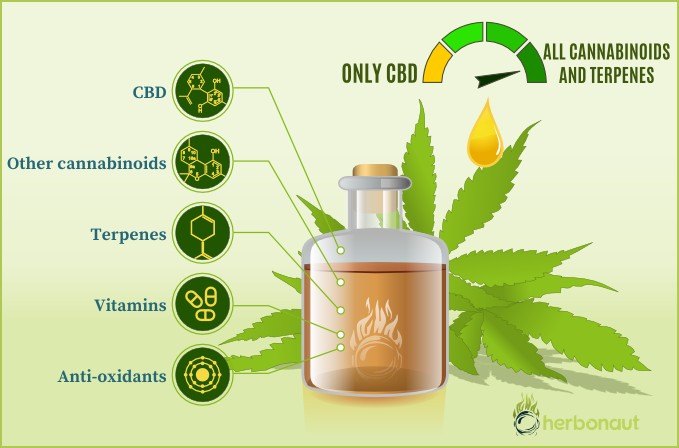
7. Science-Backed Ratios to Improve the Effectiveness of CBD and THC
When you want to combine CBD and THC, what’s the most effective dosage to get the most out of both compounds?
Well, this depends on what effects you’re looking for.
7.1 Best CBD:THC Ratio for Anxiety
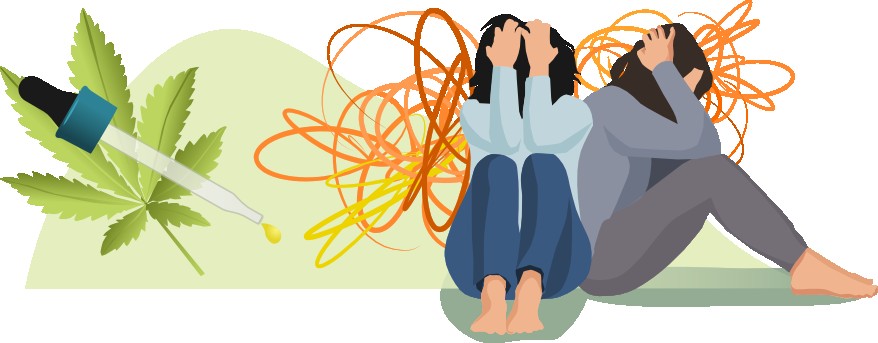
When you’re using the combination of CBD and THC to reduce anxiety, you need a ratio that’s low on THC but high on CBD.
Here’s why:
While THC taken in high doses is associated with anxiety, THC taken in low doses has been associated with the opposite effect in animal studies (19).
But what exactly is a low dose of THC? Well, this is highly dependent on various factors like:
- Your weight;
- Your metabolism;
- Your sensitivity to THC, and;
- Even how much CBD you take together with the THC (CBD counteracts some of the side effects of THC).
CBD, especially taken in high doses, has been associated with anxiety-reducing effects.
But what exactly is a high dose of CBD?
Fortunately, with CBD there’s more scientific evidence related to dosages in humans. Various studies found that CBD has anxiety-reducing effects at doses between 300 and 600 mg.
Based on these studies, our estimation for the best ratio of CBD to THC for anxiety relief is 15:1 (CBD:THC).
Examples of products that have this type of ratio are:
- Federally legal full-spectrum CBD products like oils and tinctures;
- The flower of federally legal high-CBD strains.
Related: Using CBD Oil for Anxiety
7.2 Best CBD:THC Ratio for Pain
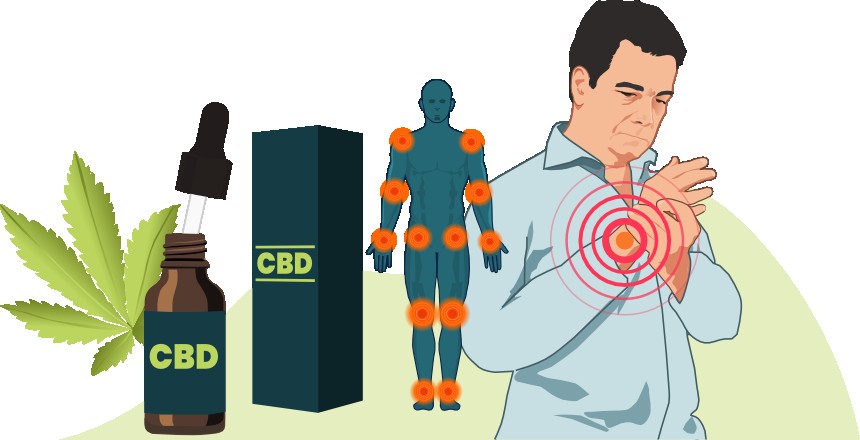
For pain, you will need a ratio that’s more even.
While both CBD and THC have been associated with pain reduction, scientific evidence suggests that THC is the more potent natural painkilling compound.
But as you learned:
Taking THC and CBD together leads to an even better reduction of pain.
Plus, THC produces unwanted side effects. And CBD is the most effective compound to reduce those unwanted side effects.
Based on scientific literature, our estimation for the best ratio of CBD to THC when you want pain relief is 1:1 (CBD:THC).
These types of products are not federally legal, and you can only obtain them in legal states.
If you don’t live in a legal state, the next best thing is to get a federally legal full-spectrum CBD product.
While a federally legal full-spectrum CBD product will always contain less than 0.3% THC and at least 2-3% CBD…
And thus giving it a ratio between 10:1 and 30:1…
It’s still a better option for pain than a CBD isolate product.
Related: Using CBD Oil for Pain
7.3 Best CBD:THC Ratio for Sleep
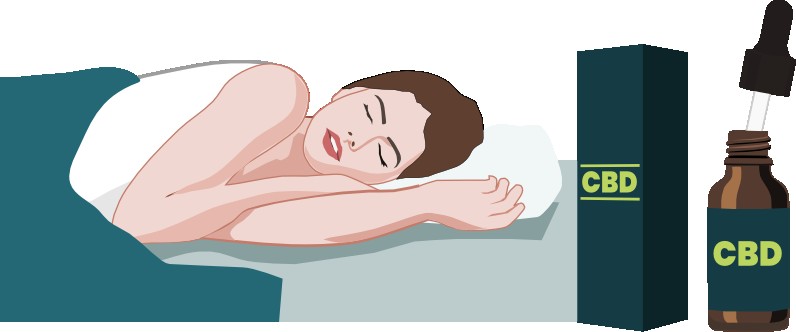
Important to mention before we get to the optimal ratio here is that:
A low dose of CBD has been associated with stimulating effects, and a high dose of CBD has been associated with sedative effects.
Therefore while the ratio is important, how much CBD and THC you consume to improve your sleep is even more important.
While THC is associated with sedative effects, studies found that at high doses, THC increases sleepiness and delays how fast you fall asleep the next day (20). This indicates that a high dose of THC interferes with good sleep.
Based on these studies, the best option for sleep would be a high-CBD, low-THC product.
In our experience, a good full-spectrum CBD product with a ratio between 10:1 and 20:1 (CBD:THC) works well to improve sleep.
Also Read: What’s the Best CBD Oil for Sleep?
8. Does CBD Need THC To Work?
CBD doesn’t need THC to work. CBD has unique effects that are not dependent on THC.
There is however some evidence suggesting that combining CBD and THC can be more effective for certain conditions, especially pain-related conditions.
For example:
There’s only one study that found CBD to be effective for pain in humans. This study was done on kidney transplant patients and the sample size was rather small (7 patients) (21).
There’s currently a cannabinoid-based medicine on the market called ‘Sativex’. This medicine contains CBD and THC in a 1:1 ratio.
Various clinical trials have proven that Sativex is effective in reducing various pain conditions, including rheumatoid arthritis (22).
There’s significantly more scientific evidence that shows a combination of THC and CBD is effective for reducing pain, compared to evidence that shows CBD is effective for reducing pain. This doesn’t necessarily mean that CBD needs THC to work. It can also mean that THC’s well-researched pain-reducing properties are more effective with CBD.
However:
When it comes to anxiety, for example, it’s the other way around. There’s significantly more scientific evidence that shows CBD alone is effective for reducing anxiety, compared to evidence that THC or a combination of CBD and THC is effective for reducing anxiety.
The bottom line:
CBD doesn’t need THC to work. THC doesn’t need CBD to work. But it’s very likely that both compounds synergize, especially when it comes to pain conditions.
9. Is CBD or THC Better for Pain?
Although CBD is associated with analgesic (painkilling) effects, THC as a natural painkilling compound has more scientific evidence backing than CBD.
However:
Based on at least two studies, best would be to combine both CBD and THC to maximize the pain-reducing properties of both compounds (15, 16).
As explained, the preferred ratio of CBD to THC for pain reduction would be 1:1.
10. Isolate and Full-Spectrum
Generally, try to avoid isolate products.
Dozens of studies suggest that CBD, THC, and all other cannabinoids and terpenes:
- Enhance each other’s beneficial effects;
- Reduce each other’s negative side effects, and;
- Create synergistic effects that are completely independent of a single isolated compound.
Related: Full-Spectrum CBD vs Isolate
11. What’s the Legal Status of CBD and THC?
Hemp-derived CBD is currently federally legal in the U.S.
THC as a stand-alone compound, on the other hand, is federally illegal.
Keep in mind that:
If your hemp-derived CBD product contains less than 0.3% THC, it is federally legal.
On the state level, laws differ per state. THC may be legal in the state where you live.
Internationally, CBD is legal in all Western Countries. THC as a stand-alone compound, on the other hand, is illegal in most Western countries.
For example:
In Europe hemp-derived CBD products that contain less than 0.2% THC are legal.
12. CBD vs THC Chart
Conclusion
It always makes sense to combine both CBD and THC.
The only reason why you would want to avoid THC is:
- You are subjected to drug tests, or;
- Highly sensitive to THC.
Isolating CBD or THC doesn’t provide unique benefits.
On the contrary, for almost any condition where research exists that looked at the effects of combining both CBD and THC, the combination of both proved to be more effective than consuming an isolated compound.
Depending on your purpose, combining both compounds in a specific ratio will prove to be more effective than combining them at random.
High doses of THC are associated with various negative side effects. CBD counteracts many of the negative side effects associated with CBD. Therefore when you want to avoid THC’s side effects, whatever ratio you choose, the maximum amount of THC should never be more than the maximum amount of CBD. At max, the ratio should always be 1:1 (CBD:THC).
What’s Next…
Go to our CBD Hub to learn more about CBD-related topics.
References
-
Pertwee, R. G. (2008). The diverse CB1 and CB2 receptor pharmacology of three plant cannabinoids: Δ9-tetrahydrocannabinol, cannabidiol and Δ9-tetrahydrocannabivarin. British Journal of Pharmacology, 153(2), 199–215. https://doi.org/10.1038/sj.bjp.0707442
-
Überall, M. A. (2020). A Review of Scientific Evidence for THC:CBD Oromucosal Spray (Nabiximols) in the Management of Chronic Pain. Journal of Pain Research, Volume 13, 399–410. https://doi.org/10.2147/jpr.s240011
-
Sagredo, O., Pazos, M. R., Satta, V., Ramos, J. A., Pertwee, R. G., & Fernández-Ruiz, J. (2011). Neuroprotective effects of phytocannabinoid-based medicines in experimental models of Huntington’s disease. Journal of Neuroscience Research, 89(9), 1509–1518. https://doi.org/10.1002/jnr.22682
-
Han, X., He, Y., Bi, G. H., Zhang, H. Y., Song, R., Liu, Q. R., . . . Xi, Z. X. (2017). CB1 Receptor Activation on VgluT2-Expressing Glutamatergic Neurons Underlies Δ9-Tetrahydrocannabinol (Δ9-THC)-Induced Aversive Effects in Mice. Scientific Reports, 7(1). https://doi.org/10.1038/s41598-017-12399-z
-
Lucatch, A. M., Coles, A. S., Hill, K. P., & George, T. P. (2018). Cannabis and Mood Disorders. Current Addiction Reports, 5(3), 336–345. https://doi.org/10.1007/s40429-018-0214-y
-
Shrivastava, A., Tsuang, M., & Johnston, M. (2011). Cannabis use and cognitive dysfunction. Indian Journal of Psychiatry, 53(3), 187. https://doi.org/10.4103/0019-5545.86796
-
Di Forti, M., Marconi, A., Carra, E., Fraietta, S., Trotta, A., Bonomo, M., . . . Murray, R. M. (2015). Proportion of patients in south London with first-episode psychosis attributable to use of high potency cannabis: a case-control study. The Lancet Psychiatry, 2(3), 233–238. https://doi.org/10.1016/s2215-0366(14)00117-5
-
Viñals, X., Moreno, E., Lanfumey, L., Cordomí, A., Pastor, A., de La Torre, R., . . . Robledo, P. (2015). Cognitive Impairment Induced by Delta9-tetrahydrocannabinol Occurs through Heteromers between Cannabinoid CB1 and Serotonin 5-HT2A Receptors. PLOS Biology, 13(7), e1002194. https://doi.org/10.1371/journal.pbio.1002194
-
Linge, R., Jiménez-Sánchez, L., Campa, L., Pilar-Cuéllar, F., Vidal, R., Pazos, A., . . . Díaz, L. (2016). Cannabidiol induces rapid-acting antidepressant-like effects and enhances cortical 5-HT/glutamate neurotransmission: role of 5-HT1A receptors. Neuropharmacology, 103, 16–26. https://doi.org/10.1016/j.neuropharm.2015.12.017
-
Zuardi, A. W., Shirakawa, I., Finkelfarb, E., & Karniol, I. G. (1982). Action of cannabidiol on the anxiety and other effects produced by ?9-THC in normal subjects. Psychopharmacology, 76(3), 245–250. https://doi.org/10.1007/bf00432554
-
Batalla, A., Bos, J., Postma, A., & Bossong, M. G. (2021). The Impact of Cannabidiol on Human Brain Function: A Systematic Review. Frontiers in Pharmacology, 11. Published. https://doi.org/10.3389/fphar.2020.618184
-
Karniol, I. G., Shirakawa, I., Kasinski, N., Pfeferman, A., & Carlini, E. A. (1974). Cannabidiol interferes with the effects of Δ9-tetrahydrocannabinol in man. European Journal of Pharmacology, 28(1), 172–177. https://doi.org/10.1016/0014-2999(74)90129-0
-
Laprairie, R. B., Bagher, A. M., Kelly, M. E. M., & Denovan-Wright, E. M. (2015). Cannabidiol is a negative allosteric modulator of the cannabinoid CB1 receptor. British Journal of Pharmacology, 172(20), 4790–4805. https://doi.org/10.1111/bph.13250
-
Laprairie, R. B., Bagher, A. M., Kelly, M. E. M., & Denovan-Wright, E. M. (2015b). Cannabidiol is a negative allosteric modulator of the cannabinoid CB1 receptor. British Journal of Pharmacology, 172(20), 4790–4805. https://doi.org/10.1111/bph.13250
-
Johnson, J. R., Burnell-Nugent, M., Lossignol, D., Ganae-Motan, E. D., Potts, R., & Fallon, M. T. (2010). Multicenter, Double-Blind, Randomized, Placebo-Controlled, Parallel-Group Study of the Efficacy, Safety, and Tolerability of THC:CBD Extract and THC Extract in Patients with Intractable Cancer-Related Pain. Journal of Pain and Symptom Management, 39(2), 167–179. https://doi.org/10.1016/j.jpainsymman.2009.06.008
-
King, K. M., Myers, A. M., Soroka-Monzo, A. J., Tuma, R. F., Tallarida, R. J., Walker, E. A., & Ward, S. J. (2017). Single and combined effects of Δ9-tetrahydrocannabinol and cannabidiol in a mouse model of chemotherapy-induced neuropathic pain. British Journal of Pharmacology, 174(17), 2832–2841. https://doi.org/10.1111/bph.13887
-
Pamplona, F. A., da Silva, L. R., & Coan, A. C. (2018). Potential Clinical Benefits of CBD-Rich Cannabis Extracts Over Purified CBD in Treatment-Resistant Epilepsy: Observational Data Meta-analysis. Frontiers in Neurology, 9. Published. https://doi.org/10.3389/fneur.2018.00759
-
Russo, E. B. (2011). Taming THC: potential cannabis synergy and phytocannabinoid-terpenoid entourage effects. British Journal of Pharmacology, 163(7), 1344–1364. https://doi.org/10.1111/j.1476-5381.2011.01238.x
-
Rubino, T., Sala, M., Viganò, D., Braida, D., Castiglioni, C., Limonta, V., . . . Parolaro, D. (2007). Cellular Mechanisms Underlying the Anxiolytic Effect of Low Doses of Peripheral Δ9-Tetrahydrocannabinol in Rats. Neuropsychopharmacology, 32(9), 2036–2045. https://doi.org/10.1038/sj.npp.1301330
-
Babson, K. A., Sottile, J., & Morabito, D. (2017). Cannabis, Cannabinoids, and Sleep: a Review of the Literature. Current Psychiatry Reports, 19(4). https://doi.org/10.1007/s11920-017-0775-9
- Cuñetti, L., Manzo, L., Peyraube, R., Arnaiz, J., Curi, L., & Orihuela, S. (2018). Chronic Pain Treatment With Cannabidiol in Kidney Transplant Patients in Uruguay. Transplantation Proceedings, 50(2), 461–464. https://doi.org/10.1016/j.transproceed.2017.12.042
- Blake, D. R., Robson, P., Ho, M., Jubb, R. W., & McCabe, C. S. (2005). Preliminary assessment of the efficacy, tolerability and safety of a cannabis-based medicine (Sativex) in the treatment of pain caused by rheumatoid arthritis. Rheumatology, 45(1), 50–52. https://doi.org/10.1093/rheumatology/kei183